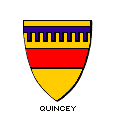
office (215)
233-4988
fax (000) 000-0000
Alt # (215) 000-0000
Brookfield Ancestor Project - Surety Barons
Magna Charta Baron Page
for
Saire De Quincey
Earl of Winchester

Return to Barons at Runnymede Page
WURTS’ MAGNA CHARTA provided a brief accounting of the feudal headquarters of some of the Magna Charta Barons. Some of the castles have been badly damaged. Some have disappeared entirely. Often we can learn of them through Medieval and Renaissance accounts, and some of them require the discerning eye of the archeologist. Others await the evidence brought out with a shovel and pick, by the trained archeological historian.
A portion of the information concerning Surety Baron SAIRE de QUINCEY is as follows:
SAIRE de QUINCEY, the Surety, born before 1154, was a Baron present at Lincoln when William the Lion of Scotland did homage to the English monarch in October 1200. He obtained large grants and immunities from King John and was created Earl of Winchester, 2 March 1207, having been governor in 1203 of the Castle of Ruil in Normandy. He is created with rewriting Magna Charta from the Charter of King Henry I and the Saxon Code. Because he had opposed the King’s concession to the Pope’s legate, he was bitterly hated by King John. One of the Barons to whom the City and Tower of London were resigned, Saire de Quincey was excommunicated with the other Barons the following year. He was sent, with Robert FitzWalter, the Surety, by the other Barons, to invite the Dauphin of France to assume the Crown of England and, even after the death of King John, he kept a strong garrison in Montsorell Castle in behalf of Prince Louis. When the Barons, being greatly outnumbered, were defeated by the troops of King Henry III, Saire de Quincey, with many others, was made prisoner and his estates forfeited. In the following October his immense estates were restored upon his submission. In 1218 the Earl of Winchester went with the Earls of Chester and Arundel to the Holy Land, assisted at the siege of Damietta in 1219, and died 3 November in the same year, on the way to Jerusalem. His wife was Margaret Beaumont, whom he married before 1173.
At the beginning of John’s reign, Saire de Quincey was not a Baron, much less a great one. In the civil war the King had had the advantage over the rebels. Few of the Barons had had much actual military experience. The Barons’ contribution to the war was the scutage they paid, a war fund substituted for the contingent of knights owed to the King’s service. The money was collected from vassals, and mercenary knights were paid from it. Many of the mercenaries were regulars who served the same Baron from campaign to campaign, but those Barons who are known to have had extensive military experience were only Saire de Quincey, Robert FitzWalter, William de Mowbray, William d’Albini, Roger de Cressi and Robert de Roos.
Saire de Quincey is associated with two stalwart Castles in the South of England: Colchester and Winchester, both with the Latin castrum root, signifying that they were once the site of Roman forts.
Colchester Castle could not have been built before the early 12th Century, though Roman materials may have been re-used in its construction. The keep, the only portion now surviving, is in complete harmony with other Norman castles. Colchester must have been a formidable stronghold, and a challenge to Saire de Quincey. The King's men held the Castle against Quincey, the first Earl to attack Colchester. John had given the fortress into the charge of a Fleming whom he thought he could trust. But Quincey took the Castle, and later found holding it more difficult. The fighting was of such a nature that John himself came to Colchester to see just how stubborn Saire de Quincey was. The Earl held the Castle for two months, but lack of food forced him to give up and take flight to France.
Colchester was the largest Norman keep in England. It measures one hundred fifty-two by one hundred seventeen feet, enclosing nearly twice the area of the Tower of London. Its walls vary between eleven and thirty feet in thickness. It was erected either by William the Conqueror or by William II. It is of the quadrangular variety, turreted at the corners. In it and elsewhere herringbone masonry has been noted.
Winchester Castle was first erected by William the Conqueror. Later alterations and extra height were added by Henry III, about the year 1138. The great Hall has Purbeck columns of 13th Century architecture, supporting a restored roof and containing handsome windows of the same approximate period. Only the keep remains. "How commonplace this saying, 'Only the keep still stands,' . . . thanks to the old builders who made the keep strong and high to withstand time, and so difficult to tear down that it escaped the looters of the ages." Perhaps Murphy was thinking of Colchester or Winchester when he thus wrote, for this was the fate of the Quincey strongholds.
Appreciation is expressed to Reed M. W. Wurts, one of the Heralds of the Society for furnishing the Baron’s Shield on this page.
Return to Barons at Runnymede Page